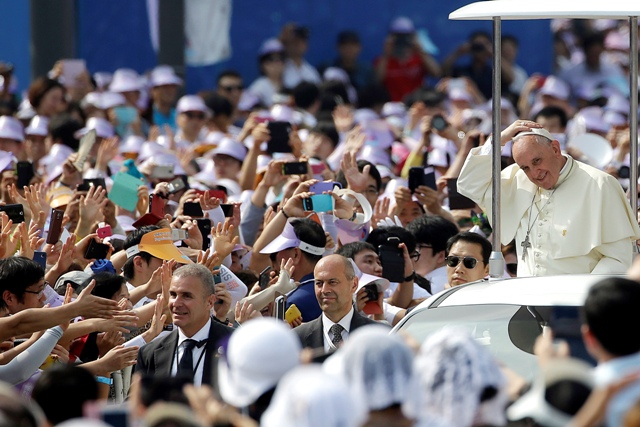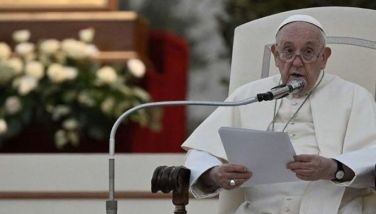Huge crowds greet pope at martyr beatification
SEOUL, South Korea — Hundreds of thousands of people turned out Saturday for one of the highlights of Pope Francis' trip to South Korea: The beatification of 124 Koreans killed for their faith over two centuries ago.
The streets leading up to Seoul's iconic Gwanghwamun Gate were packed with Koreans honoring the ordinary lay Catholics who founded the church here in the 18th century. Korea's church is unique in that it was founded not by missionaries or priests who brought the faith to the peninsula and converted people — as occurred in most of the world — but by members of Korea's own noble classes who learned of Christianity by reading books about it.
These early Catholics were killed in the 18th and 19th centuries by the Joseon Dynasty, which tried to shut the Korean Peninsula off from Western influence.

Pope Francis arrives on the popemobile to celebrate a mass and the beatification Paul Yun Ji-Chung and 123 martyr companions at Gwanghwamun Door in Seoul, South Korea, Saturday, Aug. 16, 2014. Paul Yun Ji-Chung, born in 1759, was among the earliest Catholics on the Korean Peninsula. AP/Gregorio Borgia
A collective cheer erupted from the masses when Francis declared the 124 "blessed" — the first step toward possible sainthood. Many of the women in the crowd wore lace veils; others sported paper sun visors with "Papa Francesco" written across them, protecting them from the overcast, hazy skies.
The scene was impressive, with thousands of people neatly packed into fenced-in sections leading away from the altar, which was set up in front of Gwanghwamun, the south gate to Gyeongbokgung palace, with Inwang mountain looming above and the presidential Blue House on its lower slopes. Police in green vests stood guard along the barricades and volunteers handed out water to guard against the warm, humid temperatures.
Police declined to give an estimate of the crowd size, but local media reported it had topped 1 million. The number was significant given that Catholics represent only about 10 percent of South Korea's 50 million people.
"I'm so thankful that the pope visited South Korea," said 75-year-old Yu Pil-sang, a Catholic who was trying to get a glimpse of the pope just outside the police barricade. "But I'm so sorry that all the ways to see the pope are blocked. I came to hear at least his voice."
In his homily, Francis said the lessons of the martyrs are relevant today for Korea's church, which is small but growing and is seen as a model for the rest of the world.
"They were willing to make great sacrifices and let themselves be stripped of whatever kept them from Christ — possessions and land, prestige and honor — for they knew that Christ alone was their true treasure," he said. "They challenge us to think about what, if anything, we ourselves would be willing to die for."
He praised in particular the fact that ordinary lay people were so crucial to the church's foundation and growth in Korea — a theme he was expected to develop later in the day when he meets with leaders of lay movements. The church is counting on such laymen and women to spread the faith in Asia, which the Vatican considers the future of the church.
En route to the altar before Mass, Francis stopped his open-topped car so he could get out and bless a group of families who lost loved ones in the April Sewol ferry sinking, in which more than 300 people, most of them high school students, were killed. On his white cassock, Francis wore a yellow ribbon given to him by the families a day earlier when he met with them privately to try to console them.
"We want the truth," read a yellow banner, a reference to the families' demands for an independent inquiry into the sinking. Officials said 400 families had been invited to the Mass.
The main figure in the group that was beatified is Paul Yun Ji-Chung, who was born in 1759 and was among the earliest Catholics on the peninsula. He was beheaded in 1791 — the first Korean martyr — after he violated the traditional Confucian funeral rites for his mother. In all, the Joseon Dynasty killed about 10,000 Catholics for refusing to renounce their faith.
Historians say Korea's early believers were struck by the idea of a religion that preached universal equality in divine eyes at a time when the nobility's discriminatory hierarchical system brutally exploited ordinary people.
St. John Paul II canonized another 103 martyrs during a visit to South Korea in 1984.
Francis began his day by praying at a monument in Seoul commemorating the martyrs on the site where many of them were killed.
He was supposed to have baptized the father of one of the Sewol victims who asked Francis to perform the sacrament. But a spokesman for the organizing committee of the trip, the Rev. Mattias Hur Young-yup, said the baptism would take place on Sunday.
___
Associated Press writers Youkyung Lee and Foster Klug contributed to this report.
- Latest
- Trending
































